Academic highlight: Feldman and Kappner on Supreme Court cert. decisions from 2001 to 2015

on Jun 14, 2016 at 10:15 am
The Supreme Court grants only a small fraction of the thousands of cert. petitions filed ever year. In a recent article, political scientists Adam Feldman and Alexander Kappner analyzed 93,000 petitions for certiorari filed between the October Term 2001 and the start of the October Term 2015 to determine which factors make it more likely the Court will grant cert. Although Feldman and Kappner are not the first to look closely into this question, their analysis is the most comprehensive recent study of the Roberts Court’s practices. And for those who follow the Supreme Court bar – the group of specialists who increasingly dominate briefing and oral arguments at the Court – Feldman and Kappner’s data provides an interesting breakdown of these high-powered lawyers’ success rates at the cert. stage.
Feldman and Kappner examined a number of factors unrelated to a case’s merits that might affect the likelihood of a cert. grant, including the identities of the petitioning party, the responding party, the lower court, and the lawyer and law firm involved, as well as the number of amicus briefs associated with the case. As they recognize, it is often hard to disentangle these factors from the merits of the case, which of course should play a major role in whether a petition will be granted. The more important a case, the more likely that it will be handled by a prominent attorney with expertise in Supreme Court litigation, and that many amici will support the petition. Nonetheless, their data is interesting for what it tells us about the repeat players before the Supreme Court at the cert. stage.
Interestingly, the attorneys filing the highest number of cert. petitions are not highly experienced Supreme Court litigators, but rather work for federal defenders’ offices on capital cases. Not surprisingly, however, the Supreme Court bar is well represented among the most successful petitioners. Jeffrey Fisher from the Stanford Law School’s Supreme Court litigation clinic has the best record, with a grant rate of 29.1%. Carter Phillips filed 115 cert petitions over the fifteen-year period, by far the most of repeat players before the Court, and has a healthy 16.2% grant rate. Paul Clement, this blog’s Tom Goldstein, Seth Waxman, and other prominent Supreme Court litigators also do very well at the cert. stage, greatly beating the odds for their clients. And not surprisingly, their cert. petitions were likely to be accompanied by amicus briefs, further increasing the chances the case will be granted.
Feldman and Kappner are careful not to overstate their findings. They explain that their data will help practitioners and academics “make more informed predictions about the likelihood of cert. grants,” but cannot in the end shed much light on the secretive cert. grant process. But they do identify the most active and successful lawyers and law firms at the cert. stage, who will have their work cut out for them as they try to convince an eight-member Court to take their cases over the next Term.


